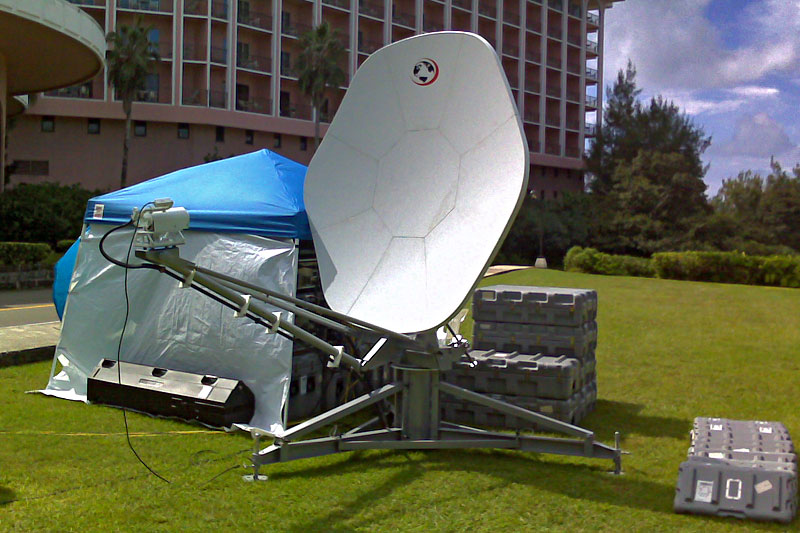When DCI brought the first commercially-viable redundant flyaway system to the market in 1988, sending the system to a location typically required specialized freight airlines. If it was a breaking story, the only way in would be an expensive private charter. While we still use charters for special circumstances (commercial airlines not operating to an area), and freight forwarders are excellent for dealing with customs, they often need two weeks to get a shipment from DCI to the location. Freight is excellent when working a pre-planned event, but for breaking news it is not a good shipping solution.
In the early days of satellite newsgathering, everything was done with analog transmission, and combined with the fact that flyaway jobs were often in areas with poor satellite coverage, flyaway dishes were very large to get the required signal level into space. This typical 2.4 meter dish alone has a half-ton shipping weight, more than twice what our current package weighs for dish and electronics! The 2.4 requires freight forwarders, and is beyond the capacity of all but heavy charter jets. Despite all the size and weight, the 2.4 would be able to run one only single analog path. Today, DCI has run as many as 8 paths off a 1.1 meter dish, and carried it as checked baggage!
The switch to digital has had the greatest effect on flyaway systems. Digital signals require less power than their old analog counterparts, meaning smaller dishes can be used, which increases and simplifies shipping options. MPEG-2 advanced into more efficient MPEG-4/H.264, meaning the same picture quality can be delivered with half the data, again lowering the required power. Now we can use smaller dishes and lighter, lower-power transmitters. The next encoding standard, MPEG-HE, for High Efficiency, is due out soon, further improving what our flyaway system can do. Digital modulation has also greatly improved over the past 10 years. For example using the old DVB-S (Digital Video Broadcasting-Satellite) standard of 4PSK, we could transmit around 7mbps of data in a 6MHz slot, and it required a Es/No (signal measurement level) of 7.0. Using the newer DVB-S2 standard of QPSK, we can transmit slightly more data in the same bandwidth, 8mbps, but the major improvement is a much lower signal level is required, only 5.5. If the signal is stronger, we can pack in more data. Using the 8PSK modulation scheme fits in 59% more data with the same signal level required for DVB-S QPSK. And if conditions allow we can move up to more complex modulation, known as “higher order”, such as 16 and 32APSK. The standard for DVB-S3 is due out in January and we eagerly look forward to what new capabilities it will bring. The combination of digital encoding and better modulation as allowed DCI to deploy a full airline-checkable HD flyaway. This greatly reduces shipping costs and logistics. Its just “grab and go”.
Many of the flyaway systems available for hire today are the older, larger dishes that will cost a fortune to ship and require weeks of transit time. And many of the newer ones that are smaller do not carry the advanced electronics that DCI does, allowing our system to do more with less weight and power. This is an important consideration when hiring a flyaway company- shipping the system may cost more than the job quote! We recently shipped a 2 path HD flyaway to Mexico for only $350 each way. As fully credentialed media members, we can take advantage of special media pricing for equipment on some airlines.
The Air Transport Association (ATA) defines the maximum dimensions and weight that can be checked as baggage on a commercial airliner. DCI is proud to have an ATA-complient flyaway system that allows us to be in the air within a few hours of a call. Combined with DCI’s full teleport service, we can offer a turnkey transmission solution, from anywhere to anywhere. DCI‘s flyaway engineers are savvy world travelers who are as comfortable in the news hotspot of the day as they are in a resort hotel. (maybe more so!) So if you need to cover a natural disaster, humanitarian crisis, or just a medical conference on a tropical island, the choice is easy- DCI is the best company to call!



